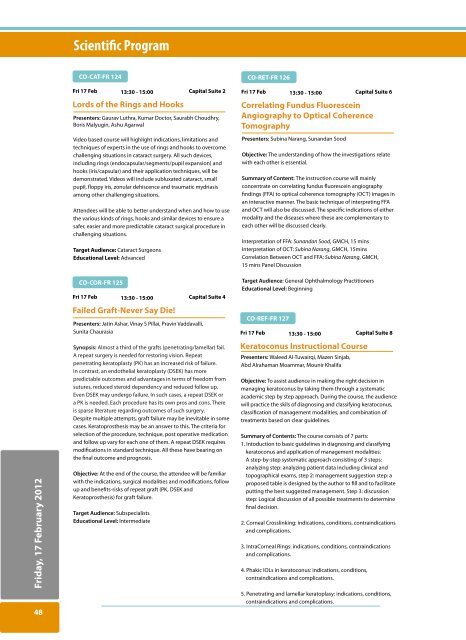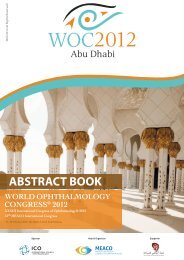ScientiËc Program - WOC2012
ScientiËc Program - WOC2012
ScientiËc Program - WOC2012
You also want an ePaper? Increase the reach of your titles
YUMPU automatically turns print PDFs into web optimized ePapers that Google loves.
Scientific <strong>Program</strong><br />
Friday, 17 February 2012<br />
48<br />
CO-CAT-FR 124<br />
Fri 17 Feb 13:30 - 15:00<br />
Capital Suite 2<br />
Lords of the Rings and Hooks<br />
Presenters: Gaurav Luthra, Kumar Doctor, Saurabh Choudhry,<br />
Boris Malyugin, Ashu Agarwal<br />
Video based course will highlight indications, limitations and<br />
techniques of experts in the use of rings and hooks to overcome<br />
challenging situations in cataract surgery. All such devices,<br />
including rings (endocapsular/segments/pupil expansion) and<br />
hooks (iris/capsular) and their application techniques, will be<br />
demonstrated. Videos will include subluxated cataract, small<br />
pupil, floppy iris, zonular dehiscence and traumatic mydriasis<br />
among other challenging situations.<br />
Attendees will be able to better understand when and how to use<br />
the various kinds of rings, hooks and similar devices to ensure a<br />
safer, easier and more predictable cataract surgical procedure in<br />
challenging situations.<br />
Target Audience: Cataract Surgeons<br />
Educational Level: Advanced<br />
CO-COR-FR 125<br />
Fri 17 Feb 13:30 - 15:00<br />
Capital Suite 4<br />
Failed Graft-Never Say Die!<br />
Presenters: Jatin Ashar, Vinay S Pillai, Pravin Vaddavalli,<br />
Sunita Chaurasia<br />
Synopsis: Almost a third of the grafts (penetrating/lamellar) fail.<br />
A repeat surgery is needed for restoring vision. Repeat<br />
penetrating keratoplasty (PK) has an increased risk of failure.<br />
In contrast, an endothelial keratoplasty (DSEK) has more<br />
predictable outcomes and advantages in terms of freedom from<br />
sutures, reduced steroid dependency and reduced follow up.<br />
Even DSEK may undergo failure. In such cases, a repeat DSEK or<br />
a PK is needed. Each procedure has its own pros and cons. There<br />
is sparse literature regarding outcomes of such surgery.<br />
Despite multiple attempts, graft failure may be inevitable in some<br />
cases. Keratoprosthesis may be an answer to this. The criteria for<br />
selection of the procedure, technique, post operative medication<br />
and follow up vary for each one of them. A repeat DSEK requires<br />
modifications in standard technique. All these have bearing on<br />
the final outcome and prognosis.<br />
Objective: At the end of the course, the attendee will be familiar<br />
with the indications, surgical modalities and modifications, follow<br />
up and benefits-risks of repeat graft (PK, DSEK and<br />
Keratoprosthesis) for graft failure.<br />
Target Audience: Subspecialists<br />
Educational Level: Intermediate<br />
CO-RET-FR 126<br />
Fri 17 Feb 13:30 - 15:00<br />
Capital Suite 6<br />
Correlating Fundus Fluorescein<br />
Angiography to Optical Coherence<br />
Tomography<br />
Presenters: Subina Narang, Sunandan Sood<br />
Objective: The understanding of how the investigations relate<br />
with each other is essential.<br />
Summary of Content: The instruction course will mainly<br />
concentrate on correlating fundus fluorescein angiography<br />
findings (FFA) to optical coherence tomography (OCT) images in<br />
an interactive manner. The basic technique of interpreting FFA<br />
and OCT will also be discussed. The specific indications of either<br />
modality and the diseases where these are complementary to<br />
each other will be discussed clearly.<br />
Interpretation of FFA: Sunandan Sood, GMCH, 15 mins<br />
Interpretation of OCT: Subina Narang, GMCH, 15mins<br />
Correlation Between OCT and FFA: Subina Narang, GMCH,<br />
15 mins Panel Discussion<br />
Target Audience: General Ophthalmology Practitioners<br />
Educational Level: Beginning<br />
CO-REF-FR 127<br />
Fri 17 Feb 13:30 - 15:00<br />
Capital Suite 8<br />
Keratoconus Instructional Course<br />
Presenters: Waleed Al-Tuwairqi, Mazen Sinjab,<br />
Abd Alrahaman Moammar, Mounir Khalifa<br />
Objective: To assist audience in making the right decision in<br />
managing keratoconus by taking them through a systematic<br />
academic step by step approach. During the course, the audience<br />
will practice the skils of diagnosing and classifying keratoconus,<br />
classification of management modalities, and combination of<br />
treatments based on clear guidelines.<br />
Summary of Contents: The course consists of 7 parts:<br />
1. Intoduction to basic guidelines in diagnosing and classifying<br />
keratoconus and application of management modalities:<br />
A step-by-step systematic approach consisting of 3 steps:<br />
analyzing step: analyzing patient data including clinical and<br />
topographical exams, step 2: management suggestion step: a<br />
proposed table is designed by the author to fill and to facilitate<br />
putting the best suggested management. Step 3: discussion<br />
step: Logical discussion of all possible treatments to determine<br />
final decision.<br />
2. Corneal Crosslinking: indications, conditions, contraindications<br />
and complications.<br />
3. IntraCorneal Rings: indications, conditions, contraindications<br />
and complications.<br />
4. Phakic IOLs in keratoconus: indications, conditions,<br />
contraindications and complications.<br />
5. Penetrating and lamellar keratoplasy: indications, conditions,<br />
contraindications and complications.






